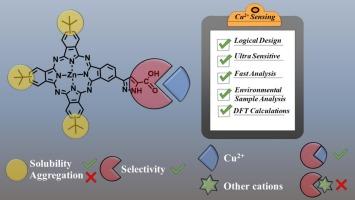A new asymmetric phthalocyanine-based chemosensor for the detection of ultra trace amount of copper (II) ions in environmental samples: comprehensive complex characterization and DFT analysis
IF 4.6
2区 化学
Q1 SPECTROSCOPY
Spectrochimica Acta Part A: Molecular and Biomolecular Spectroscopy
Pub Date : 2025-09-12
DOI:10.1016/j.saa.2025.126935
引用次数: 0
Abstract
While Cu2+ ions are essential for various biological and physiological processes, they can also induce severe neurodegenerative disorders, such as Alzheimer's and Parkinson's disease, when present in excess. Therefore, there is a pressing need to develop novel chemical sensors capable of selectively and sensitively detecting these ions in environmental samples. In this study, an A3B-type asymmetric phthalocyanine-based sensor, PCA-ZnPc-5, was developed by integrating tert-butyl groups and pyrazole moieties. These units play an active role in suppressing aggregation and increasing the solubility of the sensor molecule, as well as functioning as selective receptors against Cu2+, respectively. PCA-ZnPc-5 facilitated the detection of Cu2+ ions at the nanomolar level in environmental matrices, with no interference from other species. The applied fluorescence-based method yielded in a detection limit of 7.38 nM and an ultra-fast response time of one second. A notably significant binding constant of 4.89 × 106 M−1 confirmed the strong interaction between PCA-ZnPc-5 and Cu2+. The recovery percentages ranged from 97.9 % to 102.9 %, indicating the efficacy and suitability of PCA-ZnPc-5 for the analysis of Cu2+ in actual samples. The binding stoichiometry (1:1 ratio) and mechanism were confirmed by a comprehensive analytical approach including UV–Vis, FT-IR, MALDI-TOF Spectroscopy, and Job's Method. The 3-dimensional geometries of the probe and its Cu2+ complex were elucidated through DFT calculations, which also revealed the binding mode and the frontier molecular orbitals of the system.

一种检测环境样品中超痕量铜离子的新型不对称酞菁化学传感器:综合络合物表征和DFT分析。
虽然Cu2+离子对各种生物和生理过程至关重要,但当过量存在时,它们也会诱发严重的神经退行性疾病,如阿尔茨海默病和帕金森病。因此,迫切需要开发能够选择性和灵敏地检测环境样品中这些离子的新型化学传感器。本研究通过整合叔丁基和吡唑基团,制备了一种a3b型不对称酞菁传感器PCA-ZnPc-5。这些单位在抑制聚集和增加传感器分子的溶解度方面发挥积极作用,并分别作为选择性受体对抗Cu2+。PCA-ZnPc-5在环境基质中促进了纳米级Cu2+离子的检测,不受其他物质的干扰。该方法的检测限为7.38 nM,响应时间为1秒。结合常数为4.89 × 106 M-1,证实了PCA-ZnPc-5与Cu2+的强相互作用。回收率在97.9% ~ 102.9%之间,表明了PCA-ZnPc-5对实际样品中Cu2+分析的有效性和适用性。通过UV-Vis、FT-IR、MALDI-TOF光谱和Job’s Method等综合分析方法,确定了其结合化学计量(1:1)和机理。通过DFT计算阐明了探针及其Cu2+配合物的三维几何形状,并揭示了体系的结合模式和前沿分子轨道。
本文章由计算机程序翻译,如有差异,请以英文原文为准。
求助全文
约1分钟内获得全文
求助全文
来源期刊
CiteScore
8.40
自引率
11.40%
发文量
1364
审稿时长
40 days
期刊介绍:
Spectrochimica Acta, Part A: Molecular and Biomolecular Spectroscopy (SAA) is an interdisciplinary journal which spans from basic to applied aspects of optical spectroscopy in chemistry, medicine, biology, and materials science.
The journal publishes original scientific papers that feature high-quality spectroscopic data and analysis. From the broad range of optical spectroscopies, the emphasis is on electronic, vibrational or rotational spectra of molecules, rather than on spectroscopy based on magnetic moments.
Criteria for publication in SAA are novelty, uniqueness, and outstanding quality. Routine applications of spectroscopic techniques and computational methods are not appropriate.
Topics of particular interest of Spectrochimica Acta Part A include, but are not limited to:
Spectroscopy and dynamics of bioanalytical, biomedical, environmental, and atmospheric sciences,
Novel experimental techniques or instrumentation for molecular spectroscopy,
Novel theoretical and computational methods,
Novel applications in photochemistry and photobiology,
Novel interpretational approaches as well as advances in data analysis based on electronic or vibrational spectroscopy.

 求助内容:
求助内容: 应助结果提醒方式:
应助结果提醒方式:


